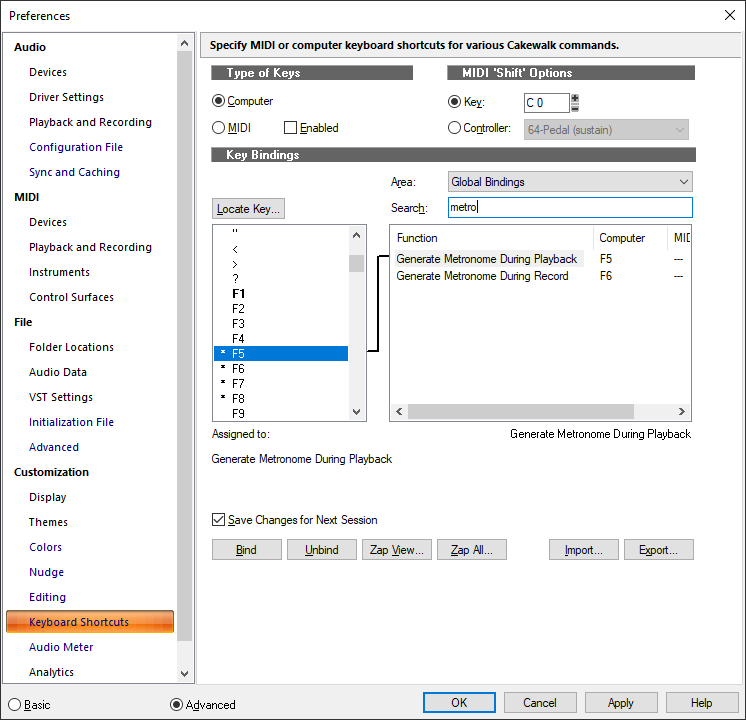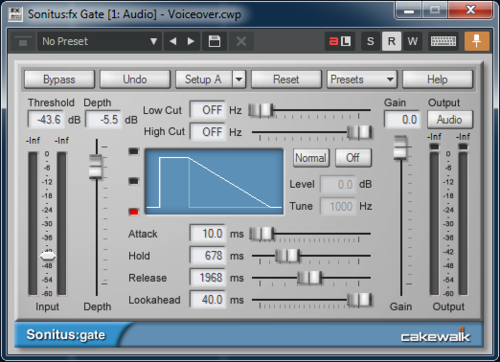-
Posts
319 -
Joined
-
Last visited
Posts posted by Panu Pentikäinen
-
-
Cakewalk is professional DAW. How do I know? -I have used it exclusively for the past 16 years to record, mix and produe music - professionally.Back in days some clients asked why I don't have Mac and why does that Pro Tools look so strange. Most musicians don't care - I could mix their songs with Notepad or hex editor and they'd be happy.
Once when Windows crashed during recording session I was told to get Mac. Still no Macs here.
I have lost one or maybe two mixing sessions in the past 20 years because I did not have Pro Tools HD.
PC+Win10+Cakewalk gives you 2x performance with 0,5x money compared to Mac.
-
 2
2
-
-
Hi guys,
I am developer of Duckbar. I have not maintained it for a while because Cakewalk has finally got many of Duckbar's essential features natively (Theme Editor, automatic waveform cache management, Tap Tempo, etc. And there are other utils available for the Tools menu editing. QuadEQ solo button is yet to come but that's not big enough feature for me to invest a week full working days to make updated Duckbar version. So currently the Duckbar project is on hold...
-Panu
-
4 hours ago, Noel Borthwick said:
A few:
It looks nice (to some)
It’s optionalIt looks nice
(to some).
It don't have to be optional.-
 1
1
-
 1
1
-
-
23 hours ago, Asif Ali said:
Small point, but the new menus are a different size font
True, but the new font size is perfect.
-
 1
1
-
-
> I want to be able to toggle the metronome off and on with a keyboard key instead of having to mute and unmute the metronome buss.
Just assign keyboard shortcuts for Metronome during playback and Metronome during recording. I've used these custom shortcuts for 15 years and they've become integral part of my daily workflow.
Also if you add keyboard shortcuts for "go to beginning of selection" and "go to end of selection", you will soon navigate faster than ever in the timeline.

My setup:
- F5 = Toggle metronome / Playback
- F6 = Toggle metronome / Record
- F7 = Go to beginning of selection
- F8 = Go to end of selection

-
 1
1
-
 1
1
-
Note that Cakewalk has built-in automatic plugin delay compensation and normally you don't need to adjust MIDI tracks manually for sync purposes.
You can turn plugin delay compensation off by clicking down the PDC button found in control panel.
-
 1
1
-
 1
1
-
-
Have you used multiple displays? Often windows open in the last used location. If you make changes in display settings then the location may go out of the visible area. For example, switching secondary display 2 to be primary could cause this. Also using dual display system from remote desktop connection may mess things up.
-
5 hours ago, John Vere said:
The OP is using a complicated set up with 2 interfaces involve. To test I would go direct from the Apollo via USB and see if the problem persists.
It'not "complicated" at all. There is only one wire coming from audio interface to PC. It's normal to use ADAT interfaces to add I/O and to provide clock sync. I have been doing this with Cakewalk & SONAR over 15 years.
I have seen similar looping related sync offset issue many times. More probable cause for this particular problem is high latency plug-ins that messing Cakewalk's internal buffers in loop mode (or similar).
-
19 minutes ago, RBH said:
I had a persistent fatal error after song load on a win 7 system.
That file is related to Direct3D 11 Runtime I think. Check if you can update DirectDraw / Direct3D drivers.
Also be aware that officially Cakewalk does not support WIn7 anymore. -
18 hours ago, mike2mars said:
Whats your new system?
Well, after 13 months it's not brand new system anymore but see my signature for specs.
-
Did Cakewalk create audio file in the project audio folder?
Check if you can find the recorded data there. -
My CbB runs much smoother in stock Windows 10 than in my old Windows 7.
Windows 10's background processes do not disturb CbB's audio streaming. -
-
2 hours ago, martsave martin s said:
thank you Panu,is there a chance you can add undo\redo button?
thanks
That's possible but the Duck is still frozen in the lake.
Let's hope sjoens can melt it free.
-
 1
1
-
 1
1
-
-
I have a simple recipe for good acoustic guitar sound:
- Good room
- Good acoustic guitar, tuned, new strings
- Good performance
- Good arrangementAfter that I can put 'any' mic in front of the guitar and it will sound good. Usual choices are KM184, U87, MD441, MD421 and Manley Reference Cardioid.
Usually I use 4 mics for acoustic guitar:
- Close mic near neck's 12th fret
- Close mic near body
- Stereo ambience mics.Good room + ambience mics = natural sounding acoustic guitar sound which does not need much processing.
-
I had similar problem with the Browser window. It happened after I had used Remote Desktop Connection. It caused Browser window location go off-screen. Two workarounds I often use in this kind of case:
- change display resolution in Windows settings temporarily
- after opening the hidden window, I press Alt-Spacebar, then M (Move). Then arrow keys to bring the hidden window back to the visible area of the desktop.
-
 1
1
-
-
Sounds promising... I'm still using ancient, 15 year old Thinkpad when travelling. I have upgraded Vista to 10 and replaced HD with SSD. I also upgraded CPU and RAM to give it more years to serve
 . Never thought I would do any music with it but now as you say I might give Cakewalk a try!
. Never thought I would do any music with it but now as you say I might give Cakewalk a try!
-
As msmcleod said, some plugins throttle down speed and there's not much what Cakewalk can do for it.
I have i9-9900k system too, and CPU usage is around 40% when exporting mixes. -
Gswitz:
> The gate should be 100% out of the way for the quietest syllable the user of the Mic speaks.That's why I'm very careful when applying gating on speech.
In normal situations I can keep all mics on but sometimes guests speak on wastly different volumes and it may cause too much bleed on the other mics.Just for clarification: "Gating" in my case is Sonitus:Gate set to reduce ~6 dB.

-
I've got a typical scneraio in podcast recording: there are 3 tracks of speech, recorded by large diagram condensers. My studio has good acoustics but I still prefer to get as dry sound as possible.
Each track has Sonitus:Gate. Settings are quite mild as I do now want to cut anything off accidentally. I have used to clean up tracks manually but it may get too time-consuming if the recording is long and guests speak over each other.
I started thinking about using gates with sidechains. Has anyone used this in podcast mixing? How do you do that? I thought something like this:
Gate = Sonitus:Gate with Sidechain input in use, duck mode
- Track1 - Gate1, Gate2
- Track2 - Gate3, Gate4
- Track3 - Gate5, Gate6
Sidechains:
- Track2 => Gate1
- Track3 =>Gate2
- Track1 => Gate3
- Track3 => Gate4
- Track1 => Gate5
- Track2 => Gate6
As a result each track ducks other tracks. But what happens if two or more guests speak over each other? Does this work IRL? What settings to use..?
-
53 minutes ago, Noel Borthwick said:
No Cake for you

I go for a walk then.

-
 1
1
-
 1
1
-
-
This is another great update. Thank you Bakers!
Is Cakewalk ready now?
-
 1
1
-
-
PDC (Plugin Delay Compensation) override is helpful when playing soft synths as it reduces latency of the played sound to minimum possible. However, if you record MIDI with PDC override enabled, Cakewalk places the recorded events in incorrect position; events (notes) are ahead more or less, depending on the plugin delay which may be anything from 1 to 200 milliseconds. After recording the take you have to move new take manually to the correct position because Cakewalk does not do that automatically.
How you do deal with this? Do you use PDC override? Do you move clips manually by ear, do you use quantize or do you just leave recorded take where it is?
Or do you bounce project and record time critical keyboards with minimal amount of time consuming plugins and PDC Override disabled?
Btw, Plugin Delay Compensation is OFF when the PDC button in the Control Bar is on. It's a little confusing but I'm talking about the scenario where that PDC button is ON.
-
Duck is deep-frozen at the moment.
Currently my daily 24 hours are barely enough for all the duties.-
 1
1
-



[CLOSED] Cakewalk 2021.09 Early Access [Updated to build 114]
in Early Access Program
Posted
Is the memory consumption that big deal? Today it should not be an issue except in older laptops.
I would like to see Cakewalk optimizing buffer size automatically behind the scenes. Now there are a dozen buffer size combobox items available but nobody knows which setting is the best and why. From end user's point of view buffer size is too technical and does not fit in Cakewalk's modern UI design principles which clearly tries to target Cakewalk for beginners and home studios. Those folks do not need understand why some buffer setting is faster and other is slower. Audio Export module could test the best buffer setting while user is setting filename and other options. On a laptop: less memory usage, on high-end PC: use as much RAM as needed.